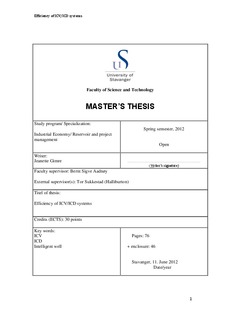| dc.description.abstract | Well completions today are very different from the traditional well completions. Reservoir complexity has increased, making horizontal wells the optimal solution in many reservoir cases, and an increase in the use of multilateral wells. This gives a need for zonal control to make it possible to drain the reservoirs in the most efficient way.
ICDs were developed to reduce the heel-toe effect and increase the horizontal well performance. ICDs respond to the differences in the physics of fluid flow in a reservoir. There has been developed in practice four types of ICDs: orifice/nozzle based (restrictive), helical-channel (frictional), the hybrid design (combination of restrictive, some friction and a tortuous pathway) and the new autonomous ICD (AICD).
An ICV is a downhole flow control valve that is being operated remotely from the surface. The ICV have the possibility to choke or shut the fluid flow. The systems that can control the ICVs can be all hydraulic, all electric, or there can be a combination of the two. The ICV is a part of an intelligent well completion. When the ICV technology was developed it had three goals in mind; to get reliable performance in HP/HT conditions, compatibility with existing downhole control and incremental-positioning systems, and enable a close-loop reservoir optimization. ICVs have the ability to choke the flow, or shut it off completely.
The analysis for the particular well case examined in this thesis showed a clear advantage of using ICVs or ICDs when water has reached the well.
Three different states were examined; early life, mid-life, and late life of the well. In the early stage there was no problem with water production for the well. So when water cut (WC) and produced oil for a conventional well completion was compared with a well completed with ICDs, and a well completed with ICVs, there was no significant difference. When the mid-life case for the well was examined, comparing the conventional well with the well with ICDs, it gave a 21% decrease in WC and 4% increase in produced oil when producing from the well with ICDs. Comparing the conventional well with the well completed with ICVs showed that in the well with ICVs, there would be a 30% decrease in WC, and increased oil production of 4,7%. In the late life case producing from the well with ICDs compared to the conventional well gave a 28% decrease in WC, and a 10% increase in oil production. Producing from the well with ICVs compared to the conventional well, gave a decrease in WC of 39%, and increase in oil production of 14%. When evaluating if ICVs, ICDs or conventional well completion should be used, the reservoir conditions should be well examined to be able to get the best possible result, with the most suitable completion. | no_NO |
